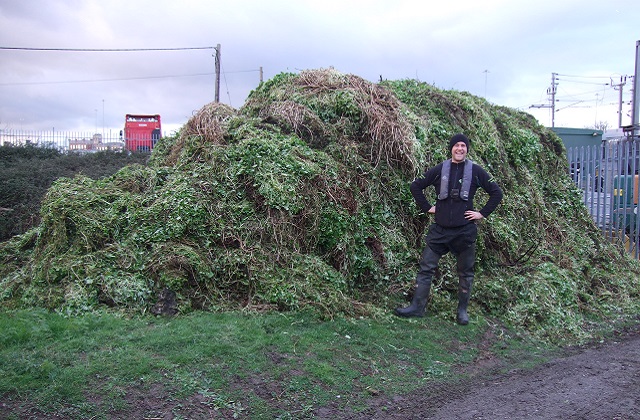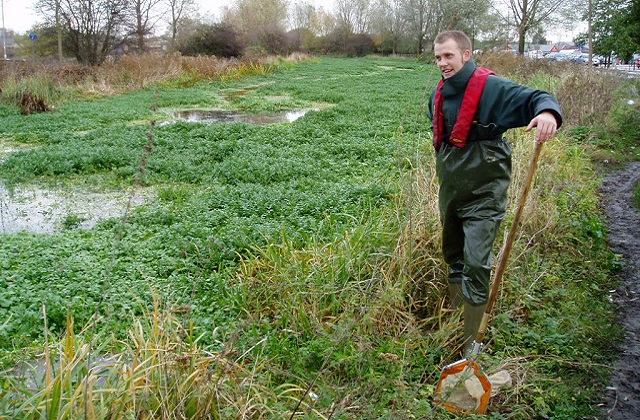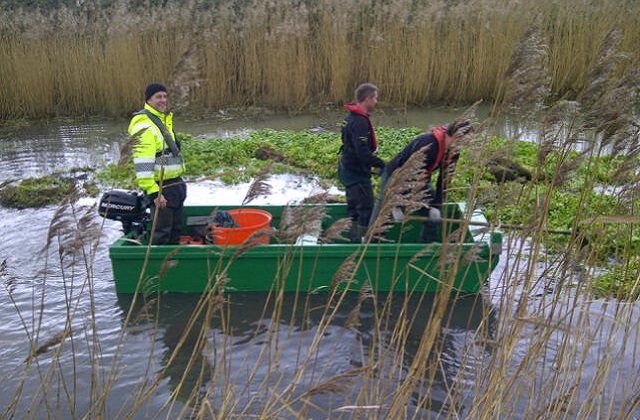Spreading itself across our waterways like a lush green carpet is one of nature’s enemies, growing up to 20cm a day and suffocating native plants and fish.
Floating pennywort, originally from America, is an invasive plant that arrived in the UK in the late 80s and has since caused havoc in the environment.
As well as having a harmful impact on the biodiversity, it is also restricting our flood alleviation structures in the rivers.
The plant is prominent in the east, in particular along the Chelmer and Blackwater catchment in Essex, but thanks to good partnership work that has developed in recent times, we are making progress.
I first became interested in this subject while studying at Glamorgan University in 2003 where I began researching its detrimental effects on invertebrate and fish populations.
Now as part of my role as a fisheries officer for the Environment Agency, I am often involved in clearance operations to rid rivers and canals of this fast-growing weed.

It usually begins to spread around late April/May and it is possible that it may be worse this year due to the warm winter we experienced, meaning it hasn’t died back as it usually does during cold spells.
One of the areas most affected was the Blackwater canal near Chelmsford and Maldon, which had been taken over by the invasive plant. It is thought that someone emptying the contents of their fish tank into the river probably caused the pennywort's arrival in the upper Chelmer and Can rivers.
Some parts of the canal were completely covered back then, which severely reduced oxygen. This meant recreational activities such as fishing and boating were unable to take place and there was a risk to livestock, dogs and human health.
In 2004/05 the Environment Agency, the Canal Trust, and volunteer groups came together in a huge effort of manual clearance and herbicide treatment to help eradicate the weed. Since then our relationship with community groups such as fishing clubs and the Rambler’s Association, has grown, which has improved our resources to tackle the issue.
Sections of the Blackwater catchment have experienced new growth since then and although this is only limited to small pockets, the potential for spread is high.

This year I worked with our operations team to remove floating pennywort from Dock River at Parkeston. Due to the habitat and fish populations that are supported by the weed, spraying and removing it by using the large weed cutting boat would have been extremely harmful, possibly resulting in fish deaths. Instead we used small boats to drag the weed to one removal point, thereby minimising water quality issues and preventing the need to cut back the important fish and water vole refuge.
The only way to prevent growth is early intervention so it is vital that people who spot this in the waterways alert us as soon as possible.
By stopping the spread at an early stage, it is much more cost effective than attempting to control species once it has become established.
However we need the public’s help to do this. Thanks to our PlantTracker app, people can now easily identify it and then report it to our 24-hour incident hotline as soon as possible on 0800 80 70 60.
To download the plant tracker app click on the here


18 comments
Comment by Briton Walker posted on
I have recently moved to a house on the River Wey KT13*XF and the river has a growing problem with Pennywort. I sopoke to the Environmental Authority who said as riparian owner it was my job to clear it. I said it might be the whole way from Weybridge to Guildford with hundreds of owners. The thenput me to the pollution department who said I must report it to the police.
I had experience with invasion of Water hyacinth and covering tropical rivers from bank to bank and experimented with composting but little job.
If you would like to talk my phone is 07940762680
Briton Walker
Comment by kathrynbooth posted on
Hello, We will take reports of Floating Pennywort in the:
North East area
the Fossdyke Navigation in the Lincs and Northants area
We don't take reports for any other areas as it remains the landowners responsibility to control the plant.
For the North East, the Environment Agency and the Rivers Trust are co-ordinating the eradication work which started in April 2012 and will last for approx 3 years. For the Fossdyke Navigation we're working with the Canal and River Trust to eradicate the species.
For any other area, customers will need to manage the plant themselves.
Eileen
Comment by Tom Berman posted on
Tom Berman:
I live by the Wargrave reach of the Thames, where Floating Pennywort arrived in October 2017. I immediately reported it to the Environment Agency, who first said plants were nothing to do with the EA and told me to talk to Natural England ! Secondly they said that the problem was “ unreportable” because “it is the landowners responsibility”. This is complete nonsense and the EA must stop it and accept their responsibility. By definition this is a floating weed and the EA has known about it for years and has allowed it to float down from the Reading area of the Thames to Sonning, to Shiplake and now to Wargrave. Next stop Henley. The fact that the stuff sometimes attaches itself to the bank, does not make it the riparian landowner’s responsibility. I have written to James Bevan, the EA Chief Executive, under whose watch this disaster has occured. No answer as yet (whatever the crisis, this bureaucracy has a charter that gives itself 10 working days before it responds to anything).
Bermantomjanet@aol,com. Tel 0118 940 3319
Comment by Tony Elliott posted on
Phone 0800 80 70 60 to report out breaks of Pennywort to the EA .
I am Chairman of ousefishing.com and we are working on the problem with them on our waters .
It is not a landowners responsibility, the EA have a legal duty to maintain and improve the environment.
Pennywort removes light and Oxygen from the water and will eventually kill off the invertebrates who are an essential part of the chain of life in our rivers .
Comment by d.g.stuart posted on
There seems to have been little done on the river Wey since Briton Walker's comments nearly three years ago (24/10/2017).
Yesterday, 7th., July, 2020, the river Wey was at some points (three) between Thames Lock and Send, impossible to navigate without danger of having one's propeller fouled by the weed. Expanses of floating pennywort are seldom out of sight as one progresses up river.
Surely it's about time that the the Jobsworths Brigade, whoever they are, stopped passing the buck, took responsibility for this mess and started sorting it out.
Please reply tour reasons for this inaction, e-mail address beow.
Douglas Stuart. Guildford.
Comment by d.g.stuart posted on
There seems to have been little done on the river Wey since Briton Walker's comments nearly three years ago (24/10/2017).
Yesterday, 7th., July, 2020, the river Wey was at some points (three) between Thames Lock and Send, impossible to navigate without danger of having one's propeller fouled by the weed. Expanses of floating pennywort are seldom out of sight as one progresses up river.
Surely it's about time that the the Jobsworths Brigade, whoever they are, stopped passing the buck, took responsibility for this mess and started sorting it out.
Please reply tour reasons for this inaction, e-mail address beo
I advised of this matter today. No reply received.
Douglas Stuart. Guildford.
This e-mail is not an advice but it is a FORMAL COMPLAINT.
No further explanation and I shall now seek the support of my M.P.
DGS
Comment by eileenroffe posted on
Good morning - I have forwarded your blog post/complaint to the complaints team for their action - Eileen
Comment by Sandra Stevenson posted on
We have the same problem on the river Frays at Uxbridge. The Pennywort is in its third or fourth year now and absolutely nothing has been done. I too was told of my responsibility under the riparian thing but at 74 I’m a bit old to don waders! The silt underneath is also rising fast and a winter of heavy rainfall will cause flooding. Guy from the environment agency was no help at all. Am trying to get a volunteer group together but not sure where to start. So sad all the ducks and birds have had to move on. Good luck with your area. Regards Sandra Stevenson.
Comment by Chloe Ellis posted on
Hello, when operations to remove Pennywort are decided, is an Environmental Impact Assessment carried out? I would love to learn more about the process if possible, as im currently a 3rd year geography student looking to write a report on the application of such EIA for invasive plant removal. Thanks in advance
Comment by eileenroffe posted on
Hello Chloe, please email us with the area you would like to work in as we do have opportunities for students to work with us. During the Covid 19 pandemic this may be put on hold but email us at: enquiries@environment-agency.gov.uk - best wishes - Eileen
Comment by Ian Evans posted on
I reported the PW issue the the EA in 2010 that I found in the Colne valley Nature Center. they never replied. I have since contacted them several times with no luck apart from once last year where they claim the onus is not upon them but the riparian owners to get rid of PW. They also said they had spent £80+ thousand on cleanups in the Colne valley area. What this money went on god only knows. Meanwhile the PW has spread to the G U Canal and is now in the tidal areas of the Thames by Hammersmith bridge. The locks south of Harefield on the canal are inoperable at times due to PW. Myself and others having made use of available studies done at Texas A & M university are using glyphosate sprayed with a non-ionic surfectant to control the weed. We have had success in keeping the river open and the fish stocks healthy. Based on facts and not knee-jerk reactions to rumors, glyphosate is perfectly safe if applied correctly and is not cancer causing. It has no residual effect and causes the PW to yellow within 10 days or so and to disappear within 3 weeks. We rake it out as much as we can as dead biomass is a source of silting. Our river is mainly PW free and has a healthy head of fish 16# barbel and 20+# pike.All of this done without the aid of the EA. There are 3 C's involved. Control, Custody and Care. If you say to fish this piece of water you need to pay us (EA) a fee you have exerted control therefore you provide care. The EA is now charging people to launch small boats in the non-tidal Thames - more control without responsibility. They are not fit for purpose.
Comment by Joanna Mansi posted on
I am a property owner on a stretch of the River Wey in Old Woking with riparian rights.
A thick green carpet of pennywort is spreading at an alarming rate, smothering and blocking the river. This stretch of the river is a local beauty spot beloved by locals for swimming and picnics. If left unchecked this will choke the river and prove fatal to fish and wildlife, as well as obstructing the river to boat navigation and swimmers.
I telephoned the Environment Agency on number 0800 80 70 60 to report this invasive plant, but was told this was the appropriate number. After being passed from pillar to post EA said they have no program to clear the waterway in Surrey, and as riparian owner it is my responsibility.
Any advice on how to remove and control this noxious plant?
Comment by eileenroffe posted on
Good morning, please can your email me at socialmedia@environment-agency.gov.uk the are team have forwarded some information - thank you in advance. ^Eileen
Comment by Clare Watson posted on
Pennywort has been spreading at an alarming rate along the river soar around Zouch, particularly this year. Huge clumps block the mill race and cling to the river banks. Flooding has sent it up the river banks smothering vegetation and dragging down small trees. Apparently it was reported to the environment agency locally and the response was that there were no plans to manage it.
Come the spring nesting will be affected and young water birds will be unable to get through it to get off the water etc. In addition to the risk to wildlife it impacts on fishing swimming paddle boarding and narrow boats. Meanwhile it must be impeding flood water flow through sluices and lock gates which is a serious risk everywhere these days . We have no guidance or leadership to manage the problem and it is beyond the capability of individuals living along the river.
clarewatson1955@gmail.com
Comment by Jonny Soars posted on
Perhaps Eileen Roffe can send us some information Clare..?
eileenroffe posted on30 October 2023
Good morning, please can your email me at socialmedia@environment-agency.gov.uk the are team have forwarded some information - thank you in advance. ^Eileen
I'm on the same stretch of the River Soar as you Clare...its dreadful.....
The EA will no doubt say they are strapped for cash and yet this summer they rebuilt the emergency flood moorings at Zouch which, in my 30 years living here no one has ever, ever used...must have cost £100k easy...... what a waste....
Comment by Linda Smith posted on
The Woking Fishing Association have done nothing to clean there waters But are still taking joining fees of over £150 per year The trouble is you can’t fish there waters because of the Floating Pennywort which is taking the oxygen from the water and the wild life are unable to get through it It is destroying our waters it’s about time they used some of this money to Clean Their Waters Ripley Surrey
Comment by steve maitland posted on
Hi i live on the river weaver and canal and river trust volunteers keep sending huge islands of pennywort down through the locks surely this is just spreading the problem
Comment by wainehartman posted on
Good Morning, If you believe this will cause blockages with potential for flooding or have negative environmental impact you can call our incident communication service on 0800 807060 24 hours a day, and our trained colleagues would be able to advise you further.
Regards